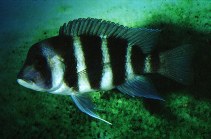| Family: |
Cichlidae (Cichlids), subfamily: Pseudocrenilabrinae |
| Max. size: |
21.01 cm SL (male/unsexed) |
| Environment: |
benthopelagic; freshwater; depth range 34 - 34 m, |
| Distribution: |
Africa: endemic to Lake Tanganyika, known from the coastal region of the southern half of the lake (Ref. 52029). |
| Diagnosis: |
Diagnosis: three scale rows between upper and lower lateral lines; 34-36 scales on longitudinal line; 31-52 outer teeth on upper jaw; body heigth 43.3-51.2% SL; predorsal 37.5-44.9% SL; length of dorsal fin base 57.1-64.6% SL; pectoral fin length 36.0-47.2% SL (Ref. 52029).
Description: Body height deepest at origin of pelvic fin; caudal peduncle thick; Hump on forehead (small in young, developing with growth); eye small and round; mouth oblique, gape when mouth is closed forming angle of about 30 degrees to horizontal axis of body; posterior edge of mouth not reaching a vertical line through anterior margin of eye; dorsal fin origin above first upper lateral line scale; four anteriormost spines increasing in length posteriorly, fourth to 16th spines about equal, three posteriormost spines slightly increasing posteriorly; each spine with a lappet near tip; soft rays branched; four (or five) anteriormost soft rays increasing in length posteriorly, thereafter length decreasing posteriorly; anal fin spines increasing in length posteriorly; each spine with a lappet near tip; three anteriormost soft rays increasing in length posteriorly, thereafter length decreasing posteriorly; upper end of pectoral fin base below base of third (or fourth) dorsal fin spine; distal tip of pectoral fin acutely pointed; fifth ray from uppermost longest, reaching a vertical line through base of second anal fin spine; pelvic fin origin below base of fourth (to sixth) dorsal fin spine; all soft rays branched, increasing in length laterally; outermost soft ray filamentous; caudal fin emarginate (Ref. 52029). |
| Biology: |
Type specimen was caught at a depth of 34 m (Ref. 52029). Cyphotilapia species are known to occur in big schools in the 30 to 40 meter layer or even deeper (Ref. 6770). |
| IUCN Red List Status: |
Not Evaluated (N.E.) Ref. (130435)
|
| Threat to humans: |
harmless |
Source and more info: www.fishbase.org. For personal, classroom, and other internal use only. Not for publication.

